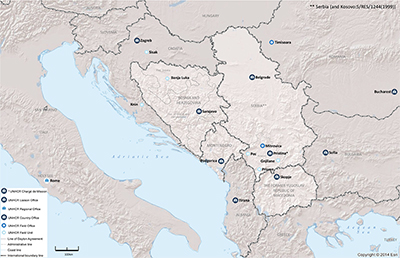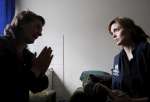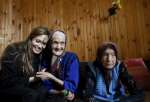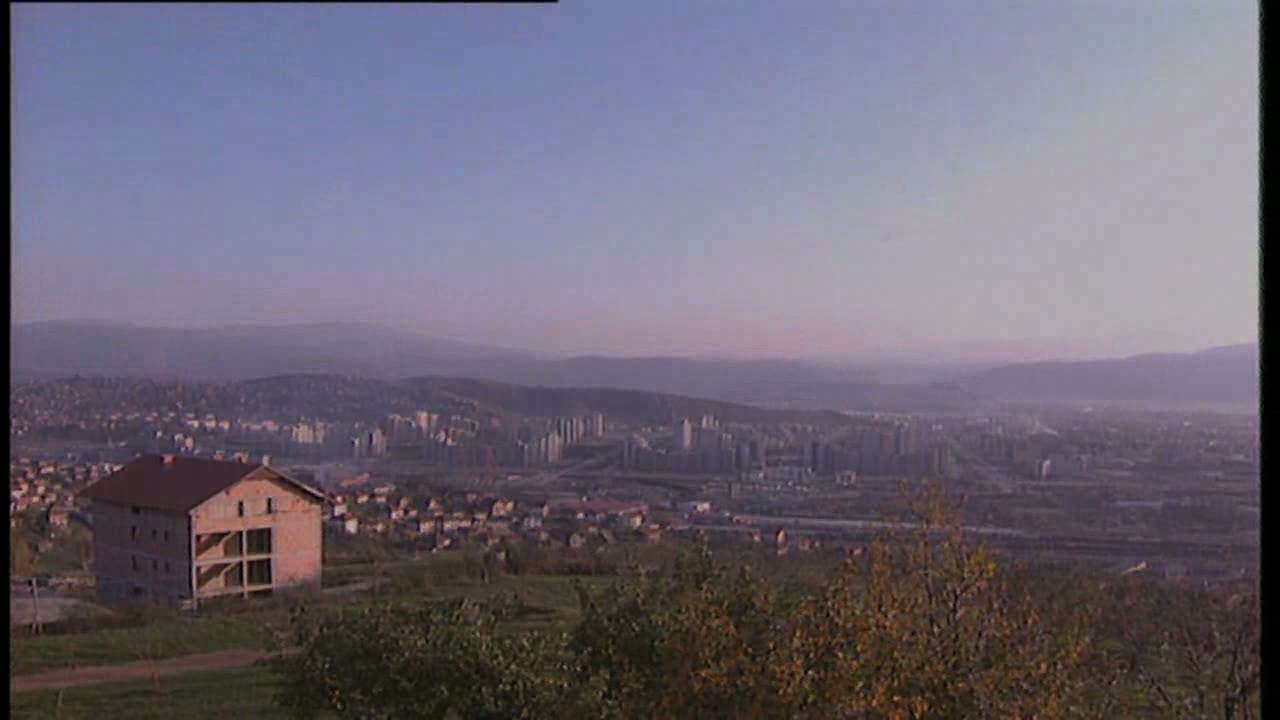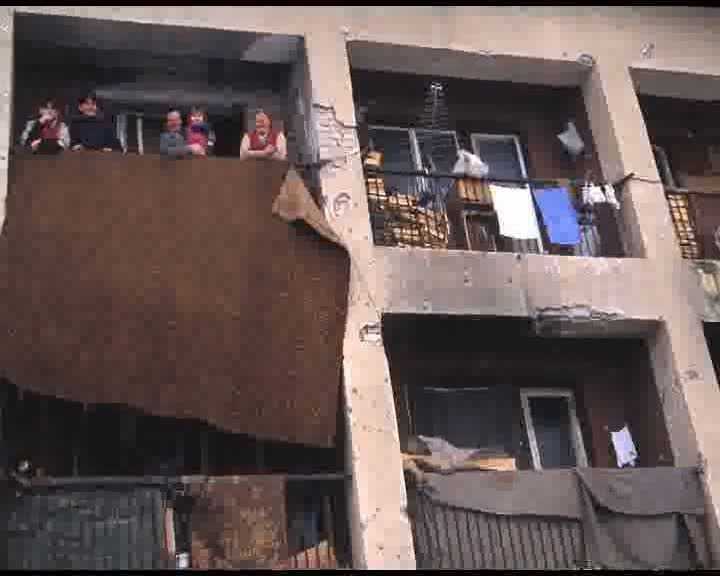Home > Where We Work > Europe > South-Eastern Europe > Bosnia and Herzegovina
2015 UNHCR subregional operations profile - South-Eastern Europe
| Overview |
While the number of asylum-seekers in South-Eastern Europe continues to rise, most national asylum systems in the subregion do not meet international standards. The majority of new asylum-seekers are Syrian, with Serbia receiving by far the largest percentage of those seeking international protection in the subregion. However, many asylum-seekers and refugees move on before their international protection needs have been assessed. Such movements are prompted in part by: difficulties in applying for asylum, for example at borders; inadequate or insufficient reception conditions; low recognition rates; or a lack of local integration prospects.
Following the regional initiative on Refugee Protection and International Migration, UNHCR, IOM and key stakeholders are pursuing dialogue with Governments in the western Balkans, at national and regional levels, to promote protection-sensitive asylum and migration systems consistent with European and international standards. UNHCR also offers technical advice to Governments across the region and provides legal assistance and direct support to particularly vulnerable people of concern.
As part of the Sarajevo Process, implementation of the Regional Housing Programme continues in Bosnia and Herzegovina, Montenegro and Serbia, as well as in Croatia (now covered under the Northern, Western, Central and Southern Europe subregion). Additional funding may be needed to provide sustainable housing solutions for all 74,000 vulnerable refugees, returnees and IDPs from the 1991-1995 conflicts. UNHCR, with OSCE, help to ensure projects provide sustainable solutions for the most vulnerable.
Advances made in the durable solutions process in the western Balkans have led UNHCR to recommend that refugee status should cease for Croatian refugees by December 2014. Where local integration or repatriation processes are still underway, this could be progressively implemented between 2014 and 2017. A similar process, which will lead to a recommendation concerning the cessation of status for refugees from Bosnia and Herzegovina, is ongoing. UNHCR is of the view that all remaining displaced people should be able to access durable solutions by the end of 2017.
Despite efforts to improve relevant laws and administrative practices, 17,000 people who are stateless or of undetermined nationality, many of whom belong to the Roma minority, continue to lack access to civil registration and documentation in the subregion. UNHCR works closely with the OSCE High Commissioner on National Minorities and the European Commission in assisting Governments to resolve civil registration and nationality-determination issues. All countries are parties to the 1954 Convention relating to the Status of Stateless Persons and only the former Yugoslav Republic of Macedonia has yet to accede to the 1961 Convention on the Reduction of Statelessness.
| Response and implementation |
In Bosnia and Herzegovina, UNHCR is working in close partnership with local authorities, NGOs and international actors to achieve solutions for the remaining 84,500 IDPs and 47,000 minority returnees. For new arrivals, the organization is working with IOM and an intra-ministerial group under a regional initiative on asylum and migration, with the aim of strengthening reception conditions and refugee status determination procedures, and reducing the use of detention for asylum-seekers. UNHCR will continue to focus on preventing statelessness and providing legal aid to existing populations, including at least 1,500 Roma, who lack birth certificates or proof of citizenship.
UNHCR's work in the former Yugoslav Republic of Macedonia is primarily aimed at assisting the Government in building and maintaining high quality asylum procedures as mixed migration movements to the country increase. The country has seen a sharp rise in arrivals from outside the region seeking asylum. The Office will continue to advocate for durable solutions for around 900 people of mainly Ashkali, Egyptian and Roma origin, and will provide direct assistance to some of the most vulnerable. UNHCR will work with the authorities to resolve the situation of another 800 people who lack civil registration and documentation, and will continue to advocate for the country's accession to the 1961 Convention on the Reduction of Statelessness and the establishment of a statelessness determination procedure.
As its European integration process progresses, national legislation and practice around Montenegro's new asylum system is being harmonized and UNHCR is offering assistance to the Government to strengthen its capacity to deal with mixed migration flows. Particular attention will be given to cross-border cooperation and prevention of refoulement. UNHCR aims to find durable solutions for the region's remaining group of people of concern. A public call for registration of people without citizenship, organized by the Ministry of the Interior and UNHCR, is scheduled for late 2014.
Serbia observed a sharp increase in asylum-seekers in 2014, with more than 5,000 new applications received by July. As these asylum-seekers arrive in mixed flows, UNHCR remains focused on safeguarding asylum space and helping to build the capacity of both national authorities and other stakeholders. The Office estimates that some 88,000 internally displaced people still need assistance and will work with the authorities on a comprehensive package of durable solutions. The Regional Housing Programme will provide permanent solutions for approximately 43,000 refugees from Croatia and Bosnia and Herzegovina. Close cooperation and coordination of activities between UNHCR and the relevant Serbian authorities will continue to address the statelessness issues of the Roma population.
The priority in Kosovo (S/RES/1244(1999)) is to strengthen the national asylum system, primarily by building the authorities' capacity to manage mixed migratory flows efficiently. UNHCR is working with the Kosovo authorities on implementing durable solutions for around 17,000 IDPs and around 10,000 people willing to return to Kosovo from the region. The Office is implementing a return and reintegration project for Ashkali, Egyptians and Roma, and returnees from camps in Montenegro and the former Yugoslav Republic of Macedonia and will provide support to community-level reconciliation initiatives. Ensuring access to birth registration and civil documentation remains central to the Office's work.
| Financial information |
Between 2011 and 2015, the financial requirements for South-Eastern Europe have steadily declined from USD 76.2 million in 2011 to USD 46.7 million in 2015, due to the progressive downscaling of operations. In 2015, the financial requirements of USD 46.7 million are set slightly higher than the 2014 budget. This is partly due to UNHCR's additional activities in Bosnia and Herzegovina for IDPs, as part of responsible disengagement, and also to the creation of a Regional Office in Sarajevo.
| UNHCR 2015 budgets for South-Eastern Europe (USD) | ||||||
|---|---|---|---|---|---|---|
| Operation | 2014 Revised budget (as of 30 June 2014) |
2015 | ||||
| Refugee programme PILLAR 1 |
Stateless programme PILLAR 2 |
Reintegration projects PILLAR 3 |
IDP projects PILLAR 4 |
Total | ||
| Total | 45,654,517 | 14,330,924 | 3,799,064 | 5,793,306 | 22,755,682 | 46,678,975 |
| 1. As from 2015, Croatia is reported under Hungary Regional Office. | ||||||
| Bosnia and Herzegovina | 9,507,353 | 2,312,335 | 799,029 | 0 | 9,738,635 | 12,850,000 |
| Croatia[1] | 3,659,377 | - | - | - | - | - |
| Kosovo (S/RES/1244 (1999)) | 7,624,823 | 1,944,161 | 1,230,293 | 5,793,306 | 215,612 | 9,183,372 |
| Montenegro | 4,620,706 | 4,330,016 | 192,020 | 0 | 0 | 4,522,036 |
| Serbia | 16,585,990 | 2,568,713 | 1,198,094 | 0 | 12,801,434 | 16,568,241 |
| The former Yugoslav Republic of Macedonia | 3,656,268 | 3,175,699 | 379,627 | 0 | 0 | 3,555,326 |
Source: UNHCR Global Appeal 2015 Update
UNHCR contact information
| Regional Representation for South Esat Europe | |||||||||||||||
|---|---|---|---|---|---|---|---|---|---|---|---|---|---|---|---|
| Style of Address | Fra Andela Zvizdovica 1, 71000 Sarajevo, Bosnia and Herzegov | ||||||||||||||
| Street Address | UNITIC Building, Fra Andjela Zvizdovica 1, 71000 Sarajevo, Bosnia and Herzegovina | ||||||||||||||
| Mailing Address | UNITIC Building, Fra Andjela Zvizdovica 1, 71000 Sarajevo, Bosnia and Herzegovina | ||||||||||||||
| Telephone | 387 33 666 160 | ||||||||||||||
| Facsimile | 387 33 290 361 | ||||||||||||||
| Website | http://unhcr.ba | ||||||||||||||
| bsnsa@unhcr.org | |||||||||||||||
| Time Zone | GMT + 1 | ||||||||||||||
| Working Hours |
|
||||||||||||||
| Public Holidays | 01 January 2016, New year 07 January 2016, Othodox christmas 01 March 2016, Independence day 28 March 2016, catholic easter 29 April 2016, Orthodox easter 02 May 2016, labor day 05 July 2016, Muslim R. Bajram 12 September 2016, Muslim K. Bajram 25 November 2016, National day 26 December 2016, christmas day |
||||||||||||||
| Comments | Countries covered: Serbia/Kosovo, FYR Macedonia, Montenegroa and Albania | ||||||||||||||

